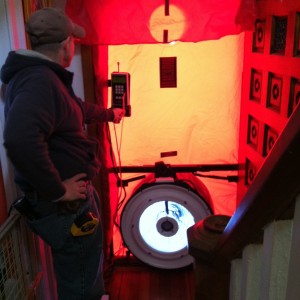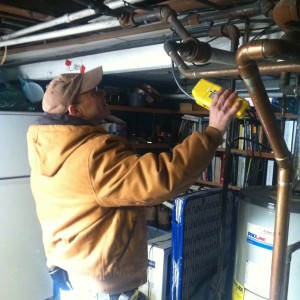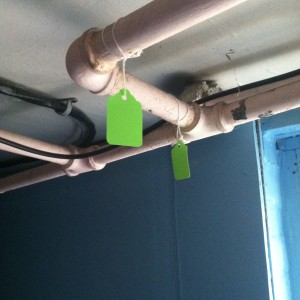My energy audit took place Thursday, January 18th. Paul Lasicki, my auditor, appeared promptly at 9:00am. After verifying that there were no immediately apparent hazzards in the house (big gas leaks, dangerous levels of carbon monoxide), he proceeded to tell me about the process and give me literature that explained it in more depth, including literature on lead safe renovation practices. My house is old and probably has some lead paint issues.
Once the formalities were dispensed with, Paul got down to work. He started with an exterior visual survey of the house and taking some overall measurements. This survey gives the auditor an impression of the house and can often show signs of energy leakage issues, especially if there has been a recent snow fall. “Hot” areas of the roof of the building can be readily seen by snow melt.
With the exterior inspection complete Paul came in and familiarized himself with all the rooms of the house. He even climbed into the attic. Then we went down to the basement where my water heater and boiler reside. The first thing he did down there was to use a gas detector to look for leaks in my gas piping, and there turned out to be a few minor ones! Gas leaks are not at all uncommon. Discovery of gas leaks and carbon monoxide issues is one of the big benefits of getting a home energy audit. Paul marked the leaks he found with green tags so that when I call my plumber in I can take him straight to them.
Next he tested the hot water heater and the boiler. He used a smoke pencil to determine how well they were drafting (reasonably well, though the boiler flue was a little anemic). He also tested the efficiency of both by drilling a hole in the flue pipe and inserting an instrument that reads the amount of carbon monoxide in the flue gasses and calculates burning efficiency. And finally, after the equipment had been running for a while, he tested the ambient air for carbon monoxide. Paul found a very low level of 1-2 ppm (35 ppm is the threshold for safety). He suggested I might want to get the boiler tuned and serviced to see if that could be eliminated.
With the water heater and furnace testing complete, Paul went upstairs to the kitchen where he proceeded to test the carbon monoxide output of the gas range. Our oven is electric, not a combustion appliance, so he did not test it. All was well with the range.
Now that all the combustion testing was complete it was time for the blower door. A blower door is a device that is inserted into the opening of the front door. It is a big fan mounted at the bottom of a nylon fabric insert. When turned on, it sucks the air out of the house to depressurize it. You then walk around the house with a smoke pencil and/or feeling with your hands to see where there are drafts, which indicates an air leak. Surprisingly for the age of my house, the results showed that I did not have a lot of leakage. Most notably there is a second flue chimney in the house that has been abandoned. The chimney was removed to below the roof line, so it communicates with the attic. Air was being sucked straight down from the attic into the basement through an open hole in the chimney at that level. This will certainly help feed what is known as the stack effect. The stack effect refers to the tendency for warm air to rise. As it does, it lowers the pressure at the bottom which invites cold air into the building. If there are ways for air to enter at the bottom, and escape at the top, considerable motion of air from bottom to top can develop. This leads to a lot of heat loss in the winter. In my case, cold air would be drawn down from the attic space in the winter to replace warm air rising.

Blower Door Installed and Running
We also determined that a door to the outside in the basement needed weather stripping as did the door from the kitchen to the outdoors.
Next, we went around counting light bulbs and their wattages. I had thought that we replaced all our incandescents with compact fluorescents, but we found a few in fixtures where they were hidden from view. Replacing incandescent bulbs with compact fluorescents is an easy way to save some money on your electricity bill.
Finally, Paul measured the size of all the windows and doors so that he could input them into the software he uses to calculate heat loss and predict energy savings.
The whole process took about four and a half hours. As Paul departed he told me that he would have my report in approximately one week. Stay tuned, my next blog post will talk about what he found and recommended in that report.

